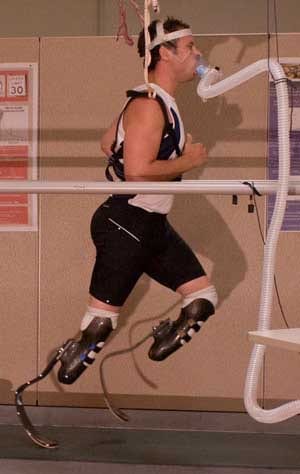The artificial lower limbs of double-amputee Olympic hopeful Oscar Pistorius give him a clear and major advantage over his competition, taking 10 seconds or more off what his 400-meter race time would be if his prosthesis behaved like intact limbs.
That’s the conclusion — released to the public for the first time — of human performance experts Peter Weyand of Southern Methodist University and Matthew Bundle of the University of Wyoming.
The Weyand-Bundle conclusion is part of a written Point-Counterpoint style debate published Nov. 19 online in the “Journal of Applied Physiology.” Weyand and Bundle were the first two authors of the study publishing the test results acquired as part of the legal appeal process undertaken after the governing body of Track and Field — the International Association of Athletics Federations (IAAF) — banned Pistorius from able-bodied track competitions, including the Olympics.
 |
| SMU’s Peter Weyand and Oscar Pistorius during testing. Marquee photo and inside photos: By Jeff Fitlow/Rice University |
In banning Pistorius, the IAAF had concluded on the basis of other data that Pistorius’ J-shaped, artificial lower limbs, called “Cheetahs” by the manufacturer, gave him a competitive advantage over able-bodied competitors. But the ban subsequently was overturned on appeal to the Court of Arbitration for Sport (CAS) in Lausanne, Switzerland.
The case has been considered groundbreaking for the eligibility of disabled athletes and the regulation of prosthetic technology in sport. Pistorius hopes to qualify for the 2012 Olympics.
The newly released conclusion from Weyand and Bundle analyzes the scientific evidence and quantifies the competitive advantage provided by Pistorius’ “Cheetah” limbs.
Weyand says: “Pistorius’ sprinting mechanics are anomalous, advantageous and directly attributable to how much lighter and springier his artificial limbs are. The blades enhance sprint running speeds by 15-30 percent.”
Below the knee, Pistorius’ limbs weigh less than half as much as the limbs of an able-bodied male sprinter.
Bundle notes that most of the 15-30 percent speed advantage enjoyed by Pistorius is explained by how quickly the lightweight blades allow him to reposition his limbs: “Even in comparison to those male sprinters with the most extreme adaptations for speed in recorded human history, Oscar Pistorius has limb repositioning times that are literally off the charts. Usain Bolt is considered somewhat freakish because he outruns his opponents by 2-4 percent. At top speed, Oscar Pistorius repositions his limbs 15 percent more rapidly than six of the most recent world record holders in the 100 meter dash, including Usain Bolt.”
Pistorius’ case was successfully presented by the law firm Dewey & LeBoeuf of New York.
“We are pleased to finally be able to go public with conclusions that the publishing process has required us to keep confidential until now. We recognized that the blades provide a major advantage as soon as we analyzed the critical data more than a year and a half ago,” said Weyand and Bundle in a statement.
Speaking for both investigators, Weyand said: “We admire the unique athletic achievements of Oscar Pistorius and are grateful for his willingness to share these important results for the general benefit of athletes and athletics.”
A different interpretation of the Pistorius data appeared as part of the written Point-Counterpoint style debate in the “Journal of Applied Physiology.”
Weyand and Bundle based their conclusions on data indicating:
Pistorius’ lightweight blades allow him to reposition his limbs 15.7 percent more rapidly than five of the most recent former world-record holders in the 100-meter dash.
The springy, lightweight blades allow Pistorius to attain the same sprinting speeds while applying 20 percent less ground force than intact-limb runners.
The springy blades reduce the muscle forces Pistorius requires for sprinting to less than half of intact-limb levels.
Peter Weyand is an associate professor of applied physiology and biomechanics in SMU’s Annette Caldwell Simmons School of Education & Human Development.
Matthew Bundle is an assistant professor of biomechanics in the College of Health Sciences at the University of Wyoming.
Read news coverage of this story.
Related links:
JAP: Point-Counterpoint “Artificial limbs do/do not make artificial running speeds possible” target=blank
JAP Study: The fastest runner on artificial legs: Different limbs, similar function?
Science Daily: Oscar Pistorius, amputee sprinter runs differently
New York Times: An amputee advantage?
Times: Oscar Pistorius to make run at London 2012
Study revives Olympic prospects for amputee sprinter
T.O. Sports: Blade runner beats the ban and his ‘Cheetahs’ are no longer ‘cheating’
AFP: ‘Bladerunner’ Pistorius wins appeal against Olympic ban
IAAF: Pistorius is eligible for IAAF competition
New York Times: Amputee ineligible for Olympic events
TIME Magazine: How Fast Can Humans Go?
